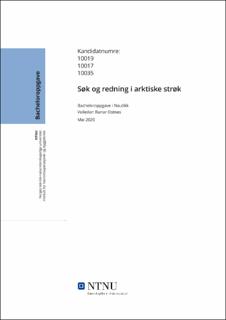| dc.contributor.advisor | Ostnes, Runar | |
| dc.contributor.author | Opsal, Christian Remøy | |
| dc.contributor.author | Nordås, Kristoffer Hågensen | |
| dc.contributor.author | Bjørnvold, Severin Andre | |
| dc.date.accessioned | 2020-07-19T16:03:10Z | |
| dc.date.available | 2020-07-19T16:03:10Z | |
| dc.date.issued | 2020 | |
| dc.identifier.uri | https://hdl.handle.net/11250/2669658 | |
| dc.description.abstract | Vi har i denne oppgaven sett nærmere på hvordan Norges søk og redningskapasitet i arktiske strøk er bygget opp. Etter hendelsen med «Viking Sky» på Hustadvika ble det stilt spørsmål ved om redningsberedskapen til Norge hadde vært i stand til å utføre en lignende redningsaksjon i arktiske strøk ved Svalbard. Nettopp dette hadde vi lyst til å finne ut i oppgaven vår.
Problemstillingen vår ble derfor som følger: «Er Norges søk og redningskapasitet tilstrekkelig til å møte den økende cruisetrafikken i arktiske strøk?»
Vi har gjennom en case undersøkt hvordan en ulykke tilnærmet lik hendelsen med «Viking Sky» ved Hustadvika ville blitt løst på Svalbard, der redningsressursene er begrenset. Vi gjennomførte en kvalitativ spørreundersøkelse og intervjuet ansatte fra tre forskjellige etater med god innsikt i søk og redningsarbeid i arktiske strøk. Vi innhentet også informasjon om Norges redningsressurser og kapasiteter gjennom dokumentstudier.
Informasjonen vi innhentet og fikk fra kontaktpersonene våre ved Hovedredningssentralen Nord-Norge, Sysselmannen på Svalbard og Kystvakten gjorde at vi fikk dannet oss et bilde av søk og redningskapasiteten som er tilgjengelige for en redningsoperasjon i arktiske strøk, og hvordan de ville håndtert en større ulykke med et passasjerfartøy.
Drøfting av dataene vi fikk inn fra kontaktpersonene våre og informasjonen vi innhentet gjennom dokumentstudier samt analysen av casen gjorde at vi kom frem til at Norges søk og redningskapasitet ikke er tilstrekkelig til å møte den økende cruisetrafikken i arktiske strøk. Selv om redningsressursene i teorien klarte å løse vår case, peker all informasjon på at søk og redningskapasiteten likevel ikke er tilstrekkelig i forhold til cruisetrafikken i arktiske strøk. «Viking Sky» er også et relativt lite cruiseskip i forhold til de største skipene som ferdes der oppe.
Det vil bli for dyrt sett opp mot kost-nytte å dimensjonere Norges søk og redningskapasitet til å skulle takle en større ulykke med et passasjerfartøy i arktiske strøk. Cruiseindustrien må tilpasse seg områdene de opererer i og myndighetene må bidra til å «lette trykket» på redningsressursene gjennom nye lover og reguleringer for cruisetrafikken som opererer i sårbare områder. | |
| dc.description.abstract | In this bachelor thesis, we have looked more closely at how Norway's search and rescue capacity in Arctic regions is structured. After the incident with the "Viking Sky" at Hustadvika, it was questioned whether the emergency preparedness in Norway had been able to carry out a similar rescue operation in Arctic regions near Svalbard. This is exactly what we wanted to find out in our thesis.
Our problem therefore became as follows: "Are Norway´s search and rescue capacity sufficient to meet the growing cruise traffic in Arctic regions?"
We have, through a case study, investigated how an accident almost similar to the incident with the “Viking Sky” at Hustadvika would have been resolved at Svalbard, where rescue resources are limited. We conducted a qualitative survey and interviewed key personnel from three different agencies with good insight into search and rescue in Arctic regions. We also obtained information about Norway's rescue resources and capabilities through document studies.The information we obtained and received from our contacts at the Joint Rescue Coordination Centres in Northern Norway, the Governor of Svalbard and the Norwegian Coast Guard made us able to form a picture of the search and rescue capabilities available for a rescue operation in Arctic regions, and how they would handle a major accident with a passenger vessel.
Discussing the data we received from our contacts and the information we extracted through the document study as well as the analysis of the case meant that we found out that Norway´s search and rescue capacity is not sufficient to meet the growing cruise traffic in Arctic regions. Although in theory the rescue resources managed to solve our case, all information indicates that search and rescue capacity are still insufficient in relation to the cruise traffic in Arctic regions. "Viking Sky" is also a relatively small cruise ship compared to the largest ships operating in arctic waters.
It would be too expensive in regard to cost-benefit to dimension Norway´s search and rescue capacity to be able to handle a large accident involving a passenger vessel in Arctic regions. The cruise industry has to adapt to the areas they operate in, and the authorities have to “relieve the pressure” on the rescue resources by making new laws and regulations for the cruise industry operating in vulnerable areas. | |
| dc.publisher | NTNU | |
| dc.title | Søk og redning i arktiske strøk | |
| dc.type | Bachelor thesis | |
